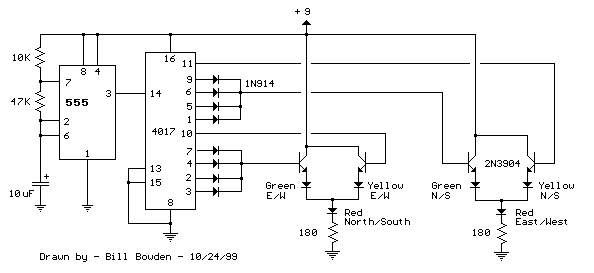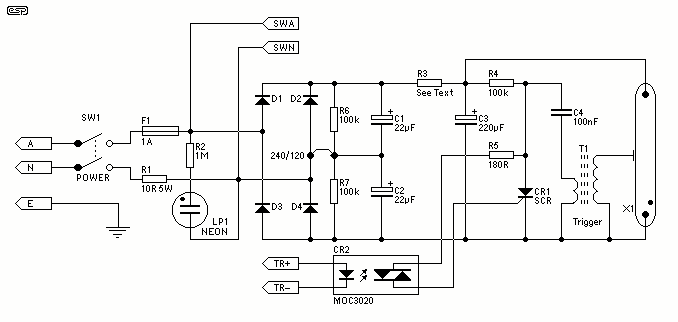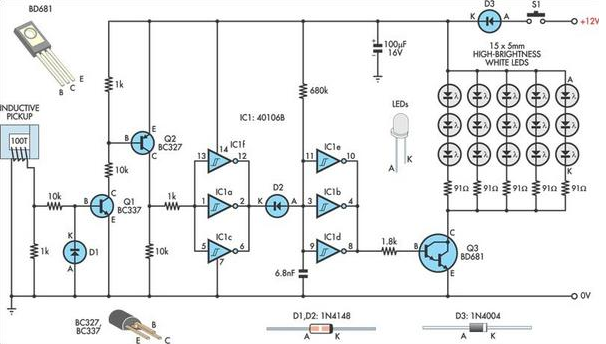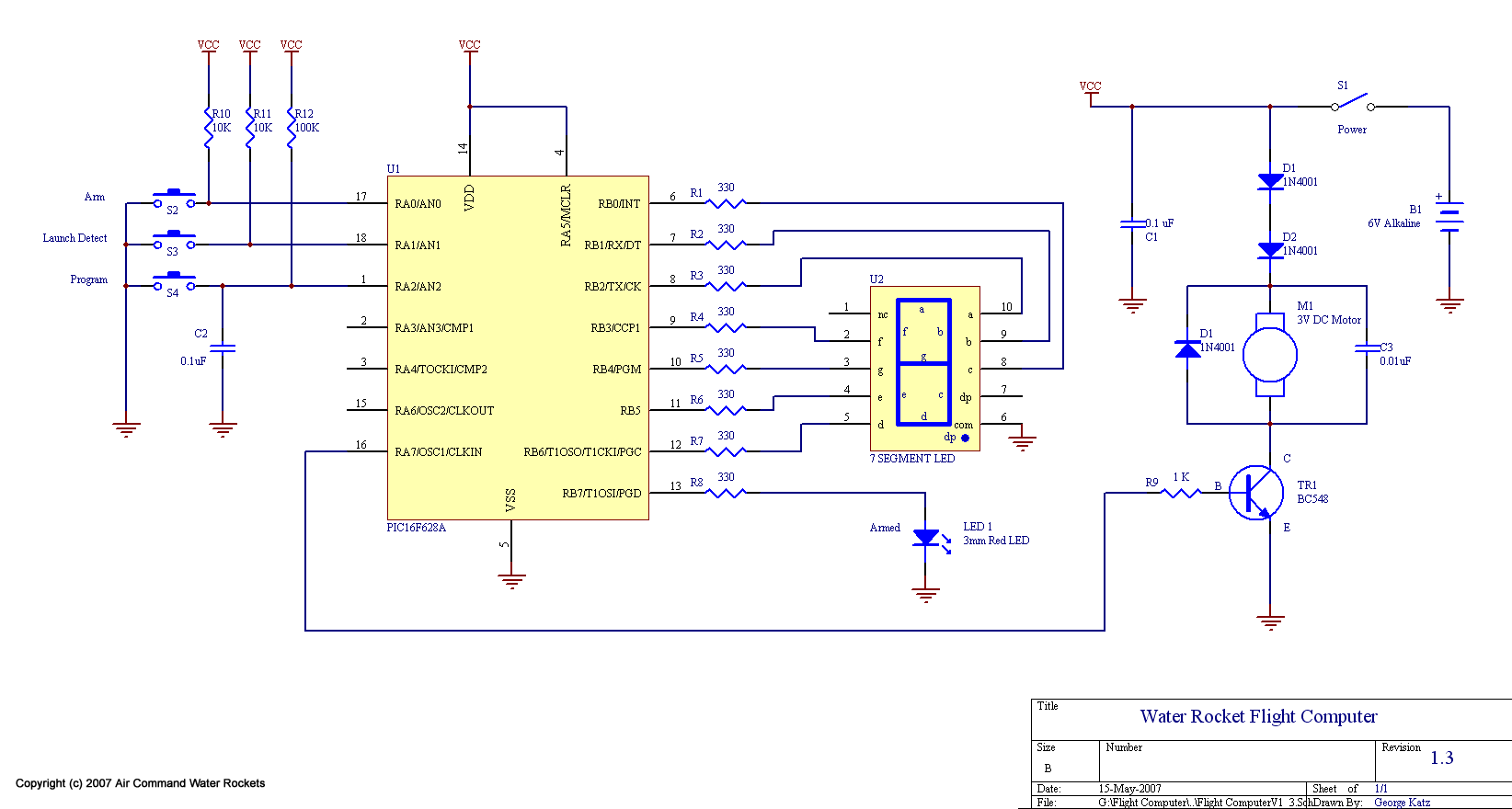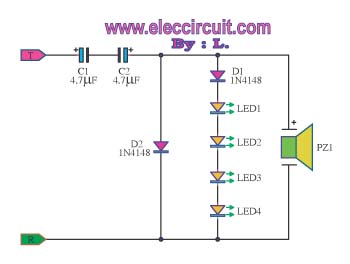
"Automatic" Light Bulb Changer
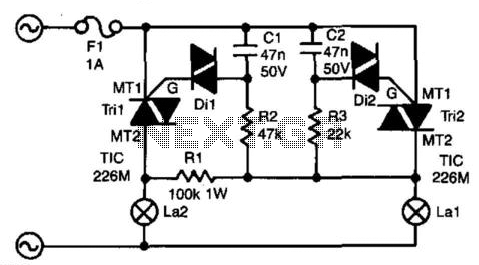
The circuit presented here ensures that if bulb La1 fails, bulb La2 will take over its function. In series with La1 is triac Tri2. Resistor R3 and capacitor C2 form a delay network. When the voltage across C2 exceeds approximately 30 V, the diac (gateless triac) D2 activates, causing Tri2 to conduct and illuminate La1. The control circuit for La2 is parallel to that of La1, but since R2/C1 has twice the delay of R3/C2, Tri1 will not be triggered when Tri2 conducts; capacitor C1 discharges, preventing Tri1 from being activated. However, when La1 is open-circuited, a voltage is present across both RC networks via La2 and resistor R1. Tri2 will initially be triggered, but since the current is less than its holding current, it will stop conducting almost immediately. Capacitor C1 will continue to charge and after a short time, Tri1 will turn on. As the time constant for La2 is slightly longer than that for La1, La2 will always be marginally dimmer than La1. To ensure equal brightness, La2 can be given a slightly higher wattage than La1. Without heatsinks, the triacs can handle up to 100 W each; with heatsinks, they can accommodate up to 1000 W. It is not advisable to use bulbs with a wattage below 25 W, as these may flicker. The triacs must be of a type that can withstand at least 400 V and 5 A. The M types used in the prototype can handle 600 V at 5 A.
This circuit operates as a failover mechanism for lighting systems, ensuring continuous illumination even if one bulb fails. The triac Tri2 is essential for controlling the operation of bulb La1, while the resistor R3 and capacitor C2 create a delay that allows for a brief moment of voltage buildup before activating the diac D2. This delay is crucial for preventing simultaneous activation of both bulbs, which could lead to flickering or inconsistent brightness levels.
When La1 fails, the circuit is designed to sense this condition through the voltage drop across the RC networks. The initial activation of Tri2 allows for a momentary current flow, but due to the holding current characteristics of Tri2, it will cease to conduct shortly after. This design ensures that Tri1 remains inactive until the system stabilizes, allowing capacitor C1 to charge sufficiently. Once charged, Tri1 activates, illuminating La2.
The time constants for the RC networks are critical in determining the operational characteristics of the bulbs. By adjusting the values of R2/C1 and R3/C2, the designer can fine-tune the delay and brightness levels of La1 and La2, ensuring that La2 provides adequate lighting without overwhelming brightness compared to La1.
The circuit is rated for robust performance, with the capability to handle significant power levels, especially when equipped with heatsinks. This feature makes it versatile for various lighting applications, though care should be taken to use appropriate wattage bulbs to prevent flickering. The selection of triacs is also important, as they must meet the voltage and current handling requirements to ensure reliable operation over time. This design exemplifies a practical approach to redundancy in lighting systems, enhancing reliability and user experience. The circuit presented here guarantees that if bulb Lai "gives up the ghost," bulb La2 will take over its tas k. In series with Lai is triac Tri2. Resistor R3 and C2 form a delay network. As soon as the voltage across C2 rises above about 30 V, diac (gateless triac) D2 is switched on, which causes Tri2 to conduct so that Lai lights. The control circuit of La2 is parallel to that of Lai, but because R2/C1 has twice the delay of R3/C2, Tril will not be triggered when Tri2 conducts; CI discharges so that Tril cannot be triggered.
When, however, Lai is open-circuited, a voltage is across both RC networks via La2 and Rl. Again, Tri2 will be triggered first, but because the current is smaller than its holding current, it will cease to conduct almost immediately. Capacitor CI will then continue to charge and after a little while Tril is switched on. Because the time constant for La2 is somewhat longer than that for Lai, La2 will always be slightly less bright than Lai.
It is, of course, possible to give La2 a slightly higher wattage than Lai to ensure equal brightness. Without heatsinks, the triacs can handle up to 100 W each; with heatsinks, powers of up to 1000 W can be accommodated.
It is not recommended to use bulbs with a wattage below 25 W, because these can flicker. The triacs can be any type that can handle at least 400 V at no less than 5 A. The M types used in the prototype can handle 600 V at 5A. 🔗 External reference
This circuit operates as a failover mechanism for lighting systems, ensuring continuous illumination even if one bulb fails. The triac Tri2 is essential for controlling the operation of bulb La1, while the resistor R3 and capacitor C2 create a delay that allows for a brief moment of voltage buildup before activating the diac D2. This delay is crucial for preventing simultaneous activation of both bulbs, which could lead to flickering or inconsistent brightness levels.
When La1 fails, the circuit is designed to sense this condition through the voltage drop across the RC networks. The initial activation of Tri2 allows for a momentary current flow, but due to the holding current characteristics of Tri2, it will cease to conduct shortly after. This design ensures that Tri1 remains inactive until the system stabilizes, allowing capacitor C1 to charge sufficiently. Once charged, Tri1 activates, illuminating La2.
The time constants for the RC networks are critical in determining the operational characteristics of the bulbs. By adjusting the values of R2/C1 and R3/C2, the designer can fine-tune the delay and brightness levels of La1 and La2, ensuring that La2 provides adequate lighting without overwhelming brightness compared to La1.
The circuit is rated for robust performance, with the capability to handle significant power levels, especially when equipped with heatsinks. This feature makes it versatile for various lighting applications, though care should be taken to use appropriate wattage bulbs to prevent flickering. The selection of triacs is also important, as they must meet the voltage and current handling requirements to ensure reliable operation over time. This design exemplifies a practical approach to redundancy in lighting systems, enhancing reliability and user experience. The circuit presented here guarantees that if bulb Lai "gives up the ghost," bulb La2 will take over its tas k. In series with Lai is triac Tri2. Resistor R3 and C2 form a delay network. As soon as the voltage across C2 rises above about 30 V, diac (gateless triac) D2 is switched on, which causes Tri2 to conduct so that Lai lights. The control circuit of La2 is parallel to that of Lai, but because R2/C1 has twice the delay of R3/C2, Tril will not be triggered when Tri2 conducts; CI discharges so that Tril cannot be triggered.
When, however, Lai is open-circuited, a voltage is across both RC networks via La2 and Rl. Again, Tri2 will be triggered first, but because the current is smaller than its holding current, it will cease to conduct almost immediately. Capacitor CI will then continue to charge and after a little while Tril is switched on. Because the time constant for La2 is somewhat longer than that for Lai, La2 will always be slightly less bright than Lai.
It is, of course, possible to give La2 a slightly higher wattage than Lai to ensure equal brightness. Without heatsinks, the triacs can handle up to 100 W each; with heatsinks, powers of up to 1000 W can be accommodated.
It is not recommended to use bulbs with a wattage below 25 W, because these can flicker. The triacs can be any type that can handle at least 400 V at no less than 5 A. The M types used in the prototype can handle 600 V at 5A. 🔗 External reference
Warning: include(partials/cookie-banner.php): Failed to open stream: Permission denied in /var/www/html/nextgr/view-circuit.php on line 713
Warning: include(): Failed opening 'partials/cookie-banner.php' for inclusion (include_path='.:/usr/share/php') in /var/www/html/nextgr/view-circuit.php on line 713
